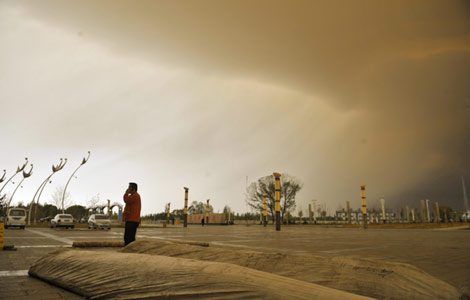Art show turns rural NY into a Chinese soundscape
Updated: 2013-04-12 11:19
By Kelly Chung Dawson in New York (China Daily)
|
||||||||
|
A sound art exhibition at Colgate University showcases works like Dajuin Yao's "Garden of Buddhahood," featuring 45 Buddhist chanting lamps. Courtesy of Mark Williams and Colgate University |
During the decades in which pop music and culture were, among other things, helping solidify America's tradition of sound art, China was essentially in a cultural vacuum.
Since then, every type of Western music has made its way to the country, providing generations of younger Chinese an education in one sonic rush. This in turn helped produce a community of sound artists that lacked an indigenous foundation but had an excess of information - a contrast that makes Chinese sound art particularly interesting today.
Revolutions Per Minute, a new exhibition at Colgate University in central New York State, showcases 35 installations of sound art - indoors and outdoors, and on and off campus in the village of Hamilton, New York. Using speakers, video projectors, iPads and 64 "chanting machines", the exhibition marks the first survey of Chinese sound art anywhere, including China.
"Every town or city has its own soundscape," said co-curator Wenhua Shi, who teaches art and art history at Colgate.
"We want to show that sound relates to all humans. Everyone can relate to sound; it crosses geographical boundaries and time. You just have to open your ears to that experience," he said.
A 36th piece will result from environmental noise collected throughout Hamilton during the exhibition, which runs through April 26. In addition, four of the 30 featured artists will remain in residence at the university. Xie Zhongqi, Wang Changcun, Samson Young and Xu Cheng (part of the Shanghai noise group Torturing Nurse) will collaborate on live performances and workshops with Colgate students.
In an essay, co-curator Dajun Yao, a sound artist who directs the Open Media Lab at the China Academy of Art, writes: "Today's China is one of the most rambunctious and noisy countries in the world. Rampant noise, especially noise in public space, such as the broadcasting of nonstop background Muzak at Shanghai subway stations, on railway trains, individuals broadcasting their private cellphone conversations at high volume, etc. This different ideology of sound, one of the most negative aspects of living in China, is, ironically, also what imbues the society with inexplicable acoustic energy.
"Built into the title of this first survey exhibition of sound art in China is obviously a pun - RPM being a measure with which we describe the different speeds of a record turntable and different types of record formats, but it also refers to the revolutionary nature of modern Chinese society, and how unbelievably fast a pace it is changing at."
In Yao's own piece, "Geophone Nanking" (2005), audiences are invited to sit inside a large black box in complete darkness, listening to field recordings of Nanjing in surround sound. The work references the practice of "diting," or "earth-listening", employed by Chinese armies 2,000 years ago. A scout would sit inside a large pottery urn, buried deep underground, listening for the encroaching enemy.
Robert McVaugh, a professor of art and art history at Colgate, said the exhibition is the most ambitious art undertaking the university has tackled in recent memory.
"The range of artists that are involved, and the cutting-edge quality of the work itself, presents the potential to take us to a place we have never reached," McVaugh said.
Another piece in the exhibition is "Buddha Machine" (2005), by FM3, a collaboration between Zhang Jian and Christian Virant. Using cheap, mass-produced Buddhist prayer machines that have been reprogrammed to play the group's own sound clips, the work is a comment on superficial adherence to religion, Yao writes.
Shi said he believes the art form is experimental in a way that will ultimately prove its importance as a cultural medium in China. The fact that people can now use personal computers and smartphones to create art opens up a world of possibility, he said.
"What we're doing in China now is making up for our lack of tradition in this area," he said. "For a long time in China, the only important attribute of sound was its loudness. And while starting out, the model we followed might have been Western, we are working to create a new tradition."
For audiences unfamiliar with the art form or with Chinese contemporary art, Yao writes: "What we can do now, is to lend our ears."
kdawson@chinadailyusa.com
(China Daily 04/12/2013 page11)

 In Photos: 7.0-magnitude quake hits Sichuan
In Photos: 7.0-magnitude quake hits Sichuan
 Li Na on Time cover, makes influential 100 list
Li Na on Time cover, makes influential 100 list
 FBI releases photos of 2 Boston bombings suspects
FBI releases photos of 2 Boston bombings suspects
 World's wackiest hairstyles
World's wackiest hairstyles
 Sandstorms strike Northwest China
Sandstorms strike Northwest China
 Never-seen photos of Madonna on display
Never-seen photos of Madonna on display
 H7N9 outbreak linked to waterfowl migration
H7N9 outbreak linked to waterfowl migration
 Dozens feared dead in Texas plant blast
Dozens feared dead in Texas plant blast
Most Viewed
Editor's Picks

|

|

|

|

|

|
Today's Top News
Live report: 7.0-magnitude quake hits Sichuan, heavy casualties feared
Boston suspect cornered on boat
Cross-talk artist helps to spread the word
'Green' awareness levels drop in Beijing
Palace Museum spruces up
First couple on Time's list of most influential
H7N9 flu transmission studied
Trading channels 'need to broaden'
US Weekly

|

|









